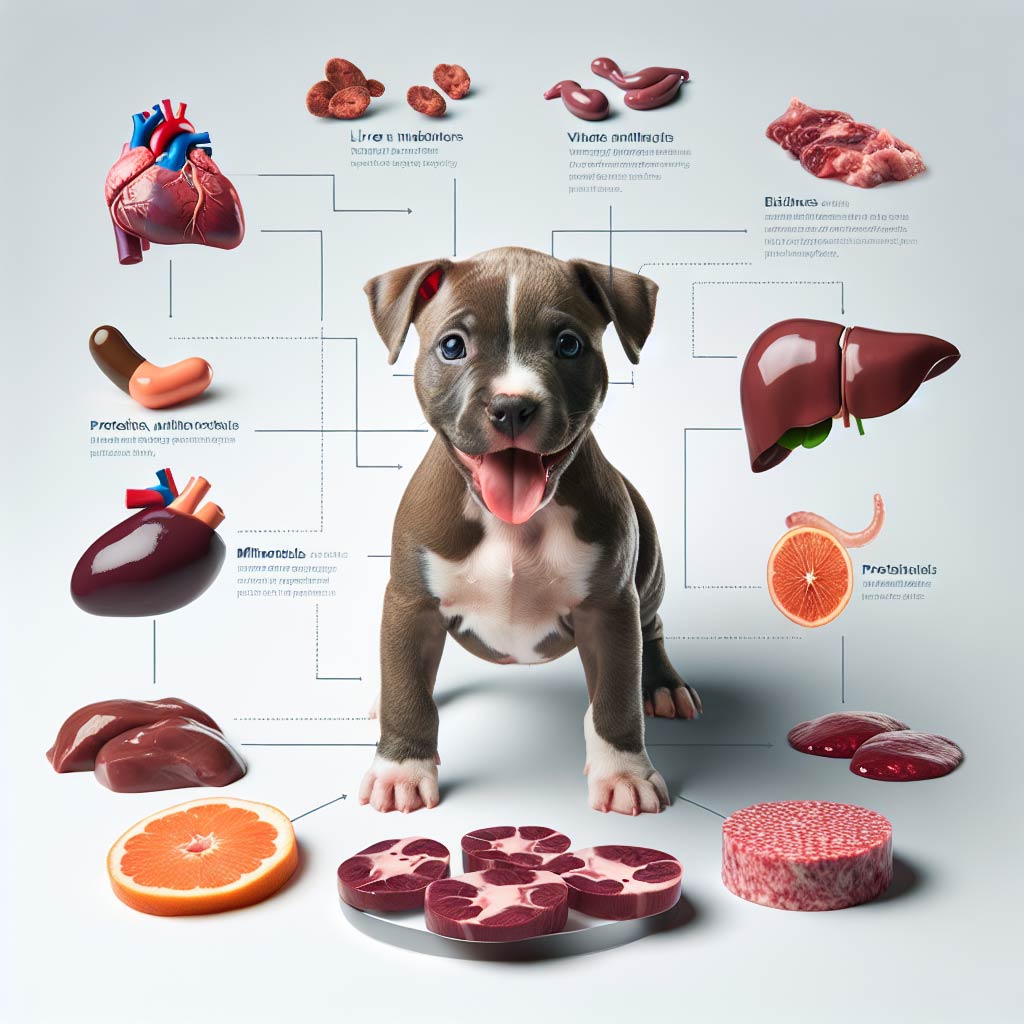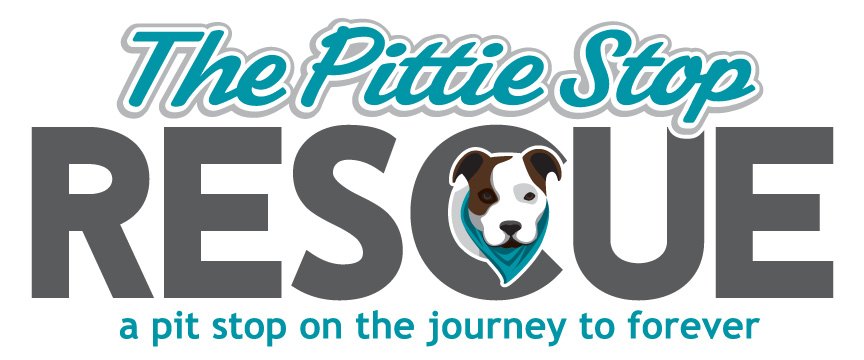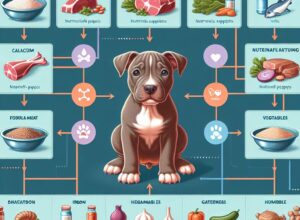
Unlocking the Power of Raw Organs for Your Pitbull Puppy
Imagine your pitbull puppy with a gleaming coat, boundless energy, and optimal health. This isn’t just a dream—it can be your reality when you introduce raw organs into their diet. Raw organ feeding is a game-changer, providing a wealth of nutrients that kibble can’t match. It’s about getting back to the roots of what dogs historically ate, ensuring they thrive, not just survive.
Maximizing Health: Why Raw Organs?
So, why choose raw organs for your pitbull puppy? It’s simple: organs are nutrient powerhouses. Packed with essential vitamins and minerals, they closely mimic the natural diet of wild canines. By incorporating organs like liver, kidneys, and heart, you’re giving your pup a natural boost to their development and overall well-being.
Consider the liver, a superfood among organs. It’s brimming with vitamin A, crucial for vision and immune function. Not to mention, it’s a rich source of iron, which is vital for healthy blood.
But it’s not just about individual nutrients. Organs contain a complex blend of components that work synergistically. This means they complement each other, enhancing absorption and maximizing health benefits. It’s about providing a holistic diet that aligns with your pitbull’s biological needs.
The Essential Raw Organs for Vibrant Pitbull Health
When it comes to selecting organs, variety is key. Each organ brings its unique profile of nutrients, so offering a range ensures your pitbull gets a well-rounded diet. Here’s a quick guide to the must-have organs:
- Liver: A true superfood, liver is rich in vitamins A, D, E, K, and B12, plus minerals like copper and iron.
- Heart: As a muscle meat, the heart is high in taurine and protein, supporting your pup’s cardiac health and muscle growth.
- Kidneys: Kidneys are a great source of selenium and B vitamins, aiding in detoxification and energy metabolism.
- Brains: Though less common, brains offer omega-3 fatty acids and cholesterol, which are vital for brain development.
- Spleen: Packed with iron and storage proteins, the spleen supports blood health and immune function.
Remember, balance is crucial. Feeding too much of one organ can lead to nutrient imbalances, so it’s important to rotate and balance these rich foods with muscle meats and bones.
Nutrient-Rich Fuel for Growing Pitbull Puppies
Your pitbull puppy is growing every day, and their diet needs to support that rapid development. Raw organs are like high-octane fuel for this growth, providing the building blocks necessary for strong bones, robust muscles, and a resilient immune system. It’s the kind of support that sets the stage for a lifetime of health.
Boosted Immunity and Enhanced Growth
Think of each organ as a specialized supplement tailored to your pitbull’s growth needs. For example, liver’s high vitamin A content isn’t just good for vision; it’s essential for proper growth, reproductive health, and immune function. Meanwhile, the heart’s amino acids support strong muscle development, which is vital for an active breed like the pitbull.
- Vitamin A from liver supports overall growth and development.
- Taurine from the heart is critical for heart health and muscle function.
- Selenium from kidneys boosts immune defenses.
- Omega-3s from brains aid in cognitive development.
- Iron from spleen ensures a robust circulatory system.
By providing these essential nutrients through a natural diet, you’re equipping your pitbull puppy with everything they need to grow up strong, healthy, and ready to take on the world.
Vital Vitamins and Minerals in Raw Organs
Raw organs are not just food; they’re a treasure trove of the vitamins and minerals your pitbull puppy needs. Let’s break it down: organs like the liver are bursting with vitamin A for healthy skin and vision, while the heart supplies zinc, essential for immune health and wound healing. Kidneys throw a punch of vitamin D into the mix, supporting bone health and calcium balance.
- Vitamin A for vision and skin health
- B vitamins for energy and brain function
- Vitamin D for bone health and calcium regulation
- Zinc for immune support and wound healing
- Iron for oxygen transport and energy
- CoQ10 for heart health and cellular energy
These are just a few examples of the nutritional goldmine found in raw organs. By incorporating these into your pitbull’s diet, you’re ensuring they receive a spectrum of nutrients that support their body’s natural processes.
Raw Organ Ratios: Crafting the Perfect Pitbull Plate
Feeding raw organs is an art and a science. The key is balance. A good rule of thumb is to make organs about 10-15% of your pitbull’s total diet. Of that, half should be liver, with the other half made up of different organs to ensure a variety of nutrients. Think of it as creating a colorful, balanced plate for your pup.
For a pitbull puppy weighing 30 pounds, aim for about 1 to 1.5 ounces of liver per day, along with a similar amount of other organs.
It’s important to start slowly and observe how your puppy reacts. Some pups might need a little more or a little less, depending on their individual health and activity levels. Monitoring your puppy’s growth, energy, and digestion will help you fine-tune their diet for optimal health.
Safe Practices: Serving Raw Organs to Your Puppy
While raw feeding has many benefits, safety should always be your top priority. This means sourcing high-quality organs, handling them properly, and ensuring they’re fresh. Avoid leaving raw organs out for too long, and always wash your hands and surfaces after preparation to prevent bacterial contamination.
- Source from reputable suppliers known for quality and safety.
- Keep organs frozen until ready to use, and thaw in the refrigerator.
- Feed organs in a clean area and clean up promptly after your puppy eats.
- Discard any uneaten raw organ meat after 20 minutes to prevent spoilage.
Remember, your puppy’s health is in your hands. Safe handling and serving practices are non-negotiable when it comes to raw feeding.
Where to Find Quality Raw Organs
Finding high-quality raw organs might seem daunting, but it’s easier than you think. Start with your local butcher or farmer’s market, where you can ask about sourcing and handling practices. Many specialty pet food stores now carry frozen raw organ options. Additionally, there are reputable online retailers that specialize in raw pet food diets.
When selecting raw organs, look for signs of freshness such as a vibrant color and a clean smell. Opt for organs from grass-fed or pasture-raised animals whenever possible, as they tend to be richer in nutrients and free from unwanted additives.
Transition Tips: Introducing Organs Into Your Puppy’s Diet
Moving to a diet rich in raw organs should be a gradual process. Start by mixing small amounts of finely chopped or ground organs with your puppy’s current food, slowly increasing the proportion over time. This slow transition helps their digestive system adjust without causing upset.
- Begin with small amounts of liver, as it’s the most nutrient-dense organ.
- Gradually introduce a variety of organs over several weeks.
- Monitor your puppy’s stool and overall well-being to gauge how they’re adjusting.
- Consult with a veterinarian familiar with raw diets to ensure a balanced transition.
With patience and careful observation, you can successfully transition your pitbull puppy to a diet that harnesses the full potential of raw organs, paving the way for a lifetime of health and vitality.
Portion Sizing and Frequency for Optimal Health
Getting the portion size and frequency right is crucial for your pitbull puppy’s health when feeding raw organs. A general guideline is to ensure that organ meats make up about 10-15% of your puppy’s total diet, with half of that being liver. The rest can be a mix of various organs to provide a range of nutrients. As for frequency, including organs in every meal is the goal, but start with a few times a week as you transition to a raw diet.
- Aim for a balance: 5% liver and 5% other organs of the total diet.
- For a 30-pound puppy, that’s roughly 1.5 to 2 ounces of organ meat daily.
- Introduce organs gradually to avoid digestive upset.
- Monitor your puppy’s condition and adjust portions as needed.
- Consult with a vet knowledgeable in raw diets for personalized advice.
Remember, each puppy is unique, and their needs can vary based on their size, activity level, and individual metabolism. Keep a close eye on your puppy’s growth and energy levels to tailor the diet to their specific needs.
Real-Life Transformations: Pitbulls Thriving on Raw Organs
The proof is in the pudding—or in this case, the raw organs. Many pitbull owners have witnessed incredible transformations in their puppies’ health and vitality after switching to a raw organ diet. These real-life stories inspire and offer a glimpse into the potential benefits of this natural feeding approach.
Pitbull Puppies and the Raw Diet: Owners’ Success Stories
One pitbull owner shared the story of their puppy, who struggled with allergies and lackluster energy. After incorporating raw organs into the diet, the puppy’s coat became shiny, and the allergies subsided significantly. Another owner reported improved muscle tone and better digestion in their pitbull puppy, attributing these changes to the nutrient-rich organ meats.
- Shiny, healthier coats and clear, allergy-free skin.
- Increased energy levels and more playful behavior.
- Improved muscle tone and strength.
- Better digestion and firmer stools.
- Enhanced immunity and fewer vet visits.
These stories highlight not just the physical benefits but also the emotional ones, as owners see their beloved pets thriving.
Visual Proof: The Physical Changes in Pitbulls on Raw Diets
Visual changes are often the most striking evidence of the benefits of raw organs in a pitbull’s diet. Owners notice brighter eyes, increased muscle definition, and a noticeable reduction in excess body fat. Puppies on raw diets often have a vibrancy that kibble-fed puppies lack, which is apparent in their appearance and behavior.
- Bright, alert eyes reflecting improved overall health.
- Defined muscles showcasing enhanced physical development.
- Leaner bodies with reduced body fat.
- More consistent and healthier-looking stools.
These physical changes are not just cosmetic; they signify a deeper, systemic health that comes from feeding a biologically appropriate diet.
Key Takeaways: Article-at-a-Glance
| Key Points | Details |
|---|---|
| Why Raw Organs? | Raw organs are packed with essential nutrients that support your pitbull puppy’s growth, development, and immune system. |
| Essential Organs | Liver, heart, kidneys, and other organs provide a variety of vital vitamins and minerals. |
| Portion Sizing | Organs should make up about 10-15% of the diet, with a balanced approach to variety and frequency. |
| Success Stories | Owners report improved coat quality, energy levels, and overall health in their pitbull puppies on raw organ diets. |
| Visual Changes | Noticeable improvements in coat, muscle definition, and body composition are common in puppies on raw diets. |
By understanding the importance of raw organs, knowing which ones to feed, and learning the correct portion sizes, you can greatly enhance your pitbull puppy’s health. The success stories and visual proof from other pitbull owners provide inspiration and confidence in the raw feeding approach. Remember to transition slowly and consult with a vet to ensure your puppy’s diet is balanced and tailored to their needs.
FAQs About Raw Organ Diets for Pitbull Puppies
What Are the Specific Benefits of Feeding My Pitbull Puppy Raw Organs?
Feeding raw organs to your pitbull puppy comes with a host of benefits that contribute to their overall health and vitality. These benefits include improved digestion due to the natural enzymes present in raw food, enhanced immune system function from the rich array of vitamins and minerals, and increased energy levels that support your puppy’s active lifestyle. Additionally, the high-quality protein found in organs supports muscle development, while the fatty acids contribute to a shiny coat and healthy skin.
- Boosted digestive health with natural enzymes
- Stronger immune system from a wealth of nutrients
- Higher energy levels for an active, playful puppy
- Support for muscle growth and maintenance
- Healthier coat and skin from essential fatty acids
By incorporating raw organs into your puppy’s diet, you’re ensuring they receive the most bioavailable form of these essential nutrients.
How Do I Know If the Raw Organs I’m Buying Are Safe and Healthy?
To ensure the raw organs you’re buying are safe and healthy, it’s important to source them from reputable suppliers. Look for providers who use responsibly raised animals, as this often translates to higher quality and fewer contaminants in the organs. Ask questions about the origin of the meat, how it was processed, and if the animals were free from hormones and antibiotics. Trustworthy suppliers will be transparent about their practices and happy to share this information with you.
- Choose suppliers with a commitment to quality and safety
- Opt for organs from animals raised without hormones or antibiotics
- Seek out providers who offer transparency about their sourcing
- Check for a clean smell and vibrant color as indicators of freshness
Remember, the health of the organs directly impacts the health benefits your puppy will receive.
Can Raw Organs Replace Commercial Dog Food Completely?
While raw organs are packed with nutrients, they should not completely replace a balanced dog food diet without careful planning. Organs are just one part of a well-rounded raw diet, which should also include muscle meat, bones, and sometimes a small amount of fruits and vegetables. It’s essential to ensure that your pitbull puppy receives all the necessary nutrients in the correct ratios. If you’re considering a full transition to raw feeding, it’s best to consult with a veterinarian or a canine nutritionist to create a balanced meal plan tailored to your puppy’s specific needs.
- Raw organs are part of a balanced diet, not the entire diet
- Ensure proper nutrient ratios with a variety of raw food components
- Consult with professionals for a tailored feeding plan
A balanced raw diet can lead to long-term health benefits, but it requires knowledge and commitment to do it right.
At What Age Can I Start Feeding Raw Organs to My Pitbull Puppy?
Raw organs can be introduced to your pitbull puppy’s diet as early as when they are weaned off their mother’s milk, usually around 8 weeks of age. Start with small amounts to allow their digestive system to adjust. It’s important to finely chop or grind the organs for easier consumption and digestion. As with any dietary change, it’s best to introduce new foods gradually and monitor your puppy’s response. If you notice any digestive upset, slow down the transition and consult with your vet.
- Begin introducing raw organs at around 8 weeks of age
- Start with small amounts and gradually increase
- Finely chop or grind organs for easier digestion
- Monitor your puppy’s response to the new diet
Early introduction of raw organs can set the foundation for a lifetime of robust health.
How Frequently Should I Feed My Pitbull Puppy Raw Organs?
Consistency is key when it comes to feeding raw organs to your pitbull puppy. A steady supply of these nutrient-rich foods should be part of their daily meals. Aim to include raw organs in each meal, keeping in mind the 10-15% guideline of their total dietary intake. As your puppy grows and their dietary needs change, you can adjust the frequency and amounts accordingly, always watching for their body’s feedback.
- Include a portion of raw organs in each meal.
- Adjust frequency and amounts as your puppy grows.
- Observe your puppy’s health and adjust the diet if necessary.
- Keep a consistent schedule to help with digestion and absorption.
Feeding raw organs regularly will help maintain a balanced nutrient intake and support your pitbull puppy’s ongoing development.
In conclusion, incorporating raw organs into your pitbull puppy’s diet can be a transformative step towards ensuring their optimal health and vitality. By understanding the benefits, knowing which organs to feed, and learning the correct portions and frequencies, you can create a diet that not only satisfies their hunger but also fuels their growth and well-being. Remember to source high-quality organs, introduce new foods gradually, and consult with a veterinarian to tailor the diet to your puppy’s specific needs. With these guidelines in mind, you’re well on your way to raising a happy, healthy, and thriving pitbull puppy.
How Do I Balance a Raw Organ Diet with Other Foods?
To balance a raw organ diet with other foods, ensure that organs make up only a portion of the overall diet. Combine organs with muscle meats, bones, and a small selection of fruits and vegetables for fiber. This creates a well-rounded meal that mimics the diversity of nutrients your pitbull would naturally consume.
- Muscle meats for protein and fat
- Bones for calcium and dental health
- Fruits and vegetables for fiber and antioxidants
Always aim for a balanced approach to provide a spectrum of nutrients for your growing puppy.
Is There a Risk of Bacteria in Raw Organs?
Like any raw food, there is a risk of bacteria in raw organs. However, this risk can be minimized with proper handling and hygiene. Purchase organs from reputable sources, store them correctly, and serve them fresh. Always clean up feeding areas and utensils thoroughly after meals.
- Buy from trusted sources to minimize contamination risks
- Practice good hygiene when handling raw organs
- Keep feeding areas clean to prevent bacterial growth
With careful management, the risk of bacteria can be significantly reduced, making raw organ feeding a safe option for your puppy.
Will My Pitbull Puppy Like the Taste of Raw Organs?
Most pitbull puppies enjoy the taste of raw organs due to their strong flavors and textures. However, taste preferences can vary. If your puppy is hesitant, try different organs or mix them with familiar foods. Patience and persistence are often key to introducing new tastes.
- Introduce a variety of organs to find your puppy’s preferences
- Mix organs with familiar foods to ease the transition
- Be patient as your puppy acclimates to new flavors
Over time, your pitbull puppy is likely to develop a taste for raw organs as part of their regular diet.
Can I Feed My Pitbull Puppy Too Many Raw Organs?
While raw organs are beneficial, it is possible to feed your pitbull puppy too much. Excessive amounts can lead to nutrient imbalances, particularly in vitamins A and D, which can be toxic in high doses. Stick to the recommended guidelines and watch for any signs of dietary excess.
- Follow the 10-15% rule to avoid overfeeding organs
- Monitor your puppy’s health for signs of nutrient excess
- Consult with a vet if you’re unsure about portion sizes
Balance is essential to prevent any potential issues from overfeeding.
How Can I Ensure My Pitbull Puppy Gets a Balanced Raw Diet?
Ensuring a balanced raw diet for your pitbull puppy involves variety, moderation, and observation. Rotate between different organ types and pair them with other diet components. Monitor your puppy’s growth, energy, and health as indicators of dietary balance. If in doubt, seek guidance from a professional who understands raw diets.
- Vary organ types and pair with muscle meats and bones
- Observe your puppy’s physical and behavioral responses to their diet
- Consult with a canine nutritionist or vet for professional advice
With these steps, you can provide a balanced and nutritious diet that supports your pitbull puppy’s health and happiness.



